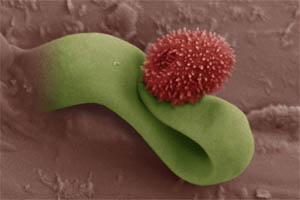New Crop Disease? It's Under Control!
Published on 17 July 2011 in Food, health and wellbeing
Ramularia leaf spot (RLS) is a new disease causing reductions in barley grain yield and quality. It was only identified in Scotland in 1998 but research by SAC has already provided farmers with the means to tackle it. Tools for rapidly detecting and controlling RLS have been developed, helping reduce the £17.52 million annual cost of the disease to the Scottish barley industry.

Key Challenges
Trying to control an emerging crop disease when relatively little is known about the organism that causes it presents a major challenge. Because yield losses caused by RLS could be high and control measures were urgently needed by farmers, initial work concentrated on highlighting the most effective fungicides. The challenge was to minimise the risk of the organism becoming resistant or insensitive to the fungicides. Changes in legislation on pesticide use, and increasing concern for the environment, have contributed to new integrated approaches to controlling RLS.

Key Benefits
In 2010 barley output in Scotland was estimated to be worth £201.5 million, making it Scotland’s most important cereal crop. During that year, 1.6 million tonnes were produced in Scotland, with 750,000 tonnes used for malting, 800,000 tonnes for feed and 50,000 tonnes for seed. RLS can reduce grain yields by as much as 0.9 tonnes per hectare, with average yield losses of 0.5t/ha, and increase the percentage of poor quality ‘thin grains’, so the disease represents a major constraint to Scottish barley production. Since 1999, SRUC research has started to provide farmers with the tools to combat RLS, helping reduce the losses in grain yield and quality. Since RLS is a major issue in Northern Europe and New Zealand, the advances made by SRUC researchers are of international significance.
“SRUC research is helping farmers combat Ramularia leaf spot, helping reduce losses in yield and quality that costs the Scottish barley industry £17.52 million a year.”
New European legislation regulating pesticides use has reduced the number of fungicides that can be used to protect crops against disease. Together with the growing concern for the environment, this has led to increased research into integrated, sustainable approaches to disease control. SRUC research has developed tools for the rapid and reliable detection of the organism causing RLS. We now understand how the organism behaves in barley plants and have identified weather conditions which contribute to disease epidemics. The development of integrated control methods, such as effective seed treatments has also helped to reduce the environmental impact of disease control.
The Scottish Government has provided £3.5 million to support work on disease control in barley. This funding provided both a solid foundation for research on barley diseases, including RLS, and the leverage to obtain £670,000 of further funding from Defra, the Levy Boards (HGCA), and industry.


Comments or Questions
Related Websites
Our Partners
SRUC’s research has been funded by the Scottish Government, HGCA, Defra, and industry. It involved collaboration with the John Innes Centre, Norwich.
Find Out More
For more information contact Dr Neil Havis, Crop & Soil Systems Research Group; Neil.Havis@sruc.ac.ukAuthor
Dr Neil Havis, Crop & Soil Systems Research Group Neil.Havis@sruc.ac.uk





